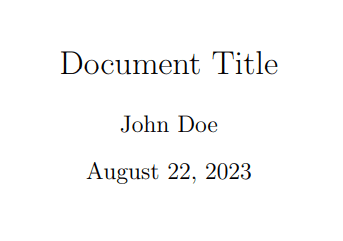Document Components
Welcome to the 'Document Components' section. Here, you'll uncover the essential building blocks that structure your content. Explore how to optimize titles, authors, abstracts, sections, and other elements for a polished and organized document.
Introduction
Document components are the building blocks that shape the structure and content of your document. From titles and headings to abstracts and sections, these elements play a crucial role in organizing and presenting information.
This guide aims to provide a comprehensive overview of the key document components commonly used in LaTeX. We will explore how to create and customize components such as the title, author, date, abstract, sections, and bibliography. Additionally, we will showcase practical example to illustrate their usage.
Components in a LaTeX document
A typical LaTeX document consists of several components that help structure and organize the content. Here are explanations of some commonly used components:
Document class
The document class is specified using the \documentclass command at the beginning of the document. It defines the overall formatting, layout, and behavior of the document.
Common document classes include article, report, book, and letter. For example, to set the document class as article, use the following command:
\documentclass{article}
Preamble
The preamble is the section between the \documentclass command and the \begin{document} command.
It is used to include packages, define custom commands, set up formatting options, and configure various settings that affect the entire document.
\documentclass{article}
% Preamble
% Add any necessary packages or custom commands here
\begin{document}
% Document content
\end{document}
Here's an example that demonstrates commands that can be included in the preamble section of a LaTeX document:
\documentclass{article}
% Packages
\usepackage{graphicx}
\usepackage{amsmath}
\usepackage[T1]{fontenc}
% Custom commands
\newcommand{\mytitle}[1]{\title{\textbf{#1}}}
\newcommand{\highlight}[1]{\textbf{\textcolor{red}{#1}}}
% Additional configurations
\setlength{\parindent}{0pt}
\setlength{\parskip}{6pt}
\begin{document}
% Document content
\end{document}
Title, author and date information
In a LaTeX document, the title, author, and date information are typically placed in the preamble section and can be automatically inserted into the document using the \maketitle command in the document body.
Here's a breakdown of each component:
1. Title
The title of the document can be set using the \title command. It typically appears at the beginning of the document and is often followed by the author's name and date.
\title{Document Title}
2. Author
The author(s) of the document can be specified using the \author command.
\author{John Doe}
Multiple authors can be separated by the \and command.
\author{John Doe \and Jane Smith}
The author(s) are usually listed below the title.
3. Date
The date of the document can be specified using the \date command. You can provide a specific date or use the \today command to automatically insert the current date;
% The \today command inserts the current date in the document.
\date{\today}
% Alternatively, you can provide a specific date in the format \date{YYYY-MM-DD} or {Month YYYY}.
\date{2022/04/8}
\date{August 2023}
4. The \maketitle command
Once you have defined the title, author, and date in the preamble, you can use the \maketitle command in the document body to generate the title, author, and date information based on the provided values. For example:
\documentclass{article}
\title{Document Title}
\author{John Doe}
\date{\today}
\begin{document}
\maketitle
% Rest of the document
\end{document}
This example generates the following output:

Abstract
The abstract is a concise summary of the document's content. It can be included using the abstract environment.
\begin{abstract}
This is the abstract of my document. It provides a brief summary of the content.
\end{abstract}
The abstract typically appears after the title and author(s) but before the main body of the document.
\documentclass{article}
\title{Document Title}
\author{John Doe}
\date{\today}
\begin{document}
\maketitle
\begin{abstract}
This is the abstract of my document. It provides a brief summary of the content.
\end{abstract}
% Rest of the document
\end{document}
Sections and Subsections
The main body of the document is divided into sections and subsections using the \section and \subsection commands, respectively. These commands create headings that help organize the content into logical sections.
The \subsubsection command is used to create subsubsections, which provide an additional level of hierarchy below subsections.
Here's an example that demonstrates the use of sections, subsections and subsubsection in a LaTeX document:
\documentclass{article}
\begin{document}
\section{Literature Review}
This section provides a review of the relevant literature.
\subsection{Theoretical Background}
This subsection presents the theoretical foundations of the research.
\subsection{Previous Studies}
This subsection discusses the key findings of previous studies in the field.
\section{Methodology}
This section describes the research methodology.
\subsection{Data Collection}
This subsection explains the process of data collection.
\subsubsection{Survey}
This subsubsection describes the survey instrument used for data collection.
\subsubsection{Interviews}
This subsubsection explains the interview process and protocol.
\subsection{Data Analysis}
This subsection discusses the analysis techniques used.
\section{Results and Discussion}
This section presents the results of the research and provides a discussion of the findings.
\subsection{Quantitative Results}
This subsection presents the quantitative data analysis results.
\subsection{Qualitative Findings}
This subsection presents the key themes and insights derived from qualitative analysis.
\end{document}
This example generates the following output:

Text Content
The text content of the document is written between the \begin{document} and \end{document} commands. This is where you write the main content of your document, including paragraphs, equations, lists, figures, tables, and other elements.
\documentclass{article}
\begin{document}
% Document content
\end{document}
Every LaTeX document requires the above three components. Everything else is optional, even text.
Anything after the \end{document} command will be ignored.
Bibliography and Citations
If your document includes references, you can manage them using the BibTeX or BibLaTeX systems. You can specify a bibliography style, create a bibliography file (.bib) with the references, and use citation commands like \cite to cite the references in the text.